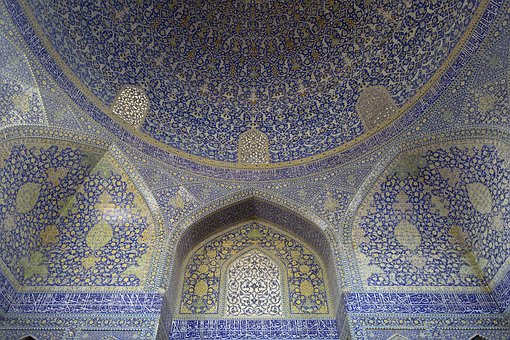
Islamic wall art the finest art, is one of the oldest forms of human art. This is indicated by the cave paintings in most of the ancient human settlements around the world, where all kinds of art were a means of primitive man in prehistoric times to embody drawings that he believed to be able to protect him and ward off evils from him. The first mural designer in history.
Read more about: 5 most famous paintings inspired by immortal literary works
Mural arts
He drew the first man before he knew writing, so mural painting was inherent to him since his inception. He found in it a haven to express himself and his existential and metaphysical questions. With his simplified drawings, he documented his beliefs, rituals and activities, and simulated what his environment contained on the walls and ceilings of caves, taking advantage of the irregular nature of the surfaces of the walls, which helped him develop his simulation of reality in its drawn forms.
Murals usually depict the activities of peoples in a civilization, by embodying a moment in time that narrates scenes ranging from hunting, gatherings, and family life, to religious and funerary scenes.
It is a mediator between artists, the public, and power, as it plays a role in creating public awareness of specific issues, in addition to the function of social and political criticism, as well as the promotion of political and societal identities.
The word mural is derived from the Latin root “murus” meaning wall, and can be artistically defined as a piece of artwork painted or technically applied to a mural surface. A mural is also known, in the fine arts, as a drawing applied directly to the surface of a wall or ceiling, or drawn on a canvas and then fixed.
Mural painting is inherently different from all other forms of pictorial art, being organically linked to architecture. The use of color, design and topical treatment can radically alter the sense of a building’s spatial proportions.
Thus, the mural image is the only three-dimensional form of pictorial drawing, due to its ability to modify the area it is applied to.
Read more about: https://islamicwallartstore.com/
Islamic wall art the finest art
Islamic art, at the beginning of its formation in the Levant, was influenced by Sasanian, Byzantine, and Persian art, and this influence was evident in the cladding of walls and floors with mosaics of glass and stone. Colored and glazed ceramics and ceramic pieces, as well as the use of various types of semi-precious stones and shells to emphasize the appearance of richness in the artwork.
But mural painting in the Islamic era was unique from other arts that preceded it, through its clear influence on the orientations of the Islamic faith. The Muslim artist mastered the use of wall inscriptions (which do not contain drawings), engravings and inlays with other materials, so the art of securitization (arabesque) appeared and the use of overlapping geometric shapes, coordinating them and formulating them in wonderful artistic forms, in addition to plant decorations with their wavy branches, and calligraphic decorations, specifically the Kufic line and the Naskh line.
The Muslim artist was famous for his abstract art, so he used the plant decorative unit, stripping it of its natural form and turning it into geometric shapes that give a sense of continuity.
Wall photography techniques
“Tempera” is a method of coloring based on water-based dry colourants, which are prepared by mixing them with an adhesive, water-based medium such as natural resins such as gum arabic (which produces gouache), animal glue, egg whites, or melted wax. It is used as adhesive or color-fixing media, and is applied on a floor. dry calcareous
And “fresco” or wet photography, whose colors are prepared from dust, herbs, or precious stones to produce rare tones, and are ground and mixed with stabilizers, then painted and painted on a wet calcareous floor. After it dries, a preservative and insulating surface layer of egg white is added.
And “oil painting”, which depends on mixing the color pigment with a carrier oil medium from one of the transparent oils that can dry, to produce solid color particles that are protected by the oil from all weather factors.
“Mosaics” or mosaics are designed using small, multi-colored pieces of glass, colored marble, or ceramic materials, so that they are arranged side by side to produce decorative, geometric, or botanical themes and fixed with mortar, in addition to the “acrylic” technique, stained glass, and other modern techniques.